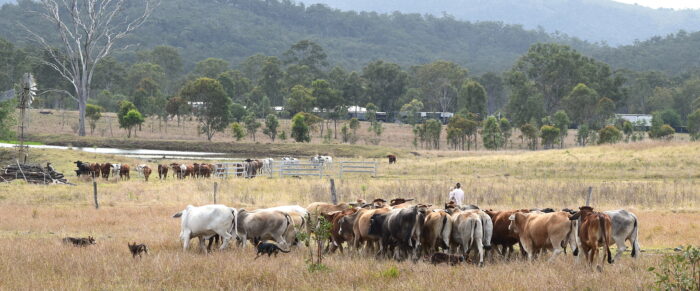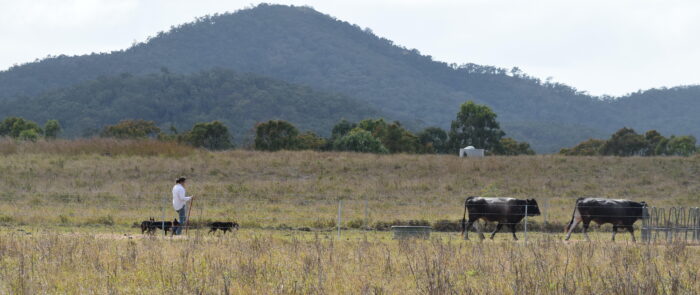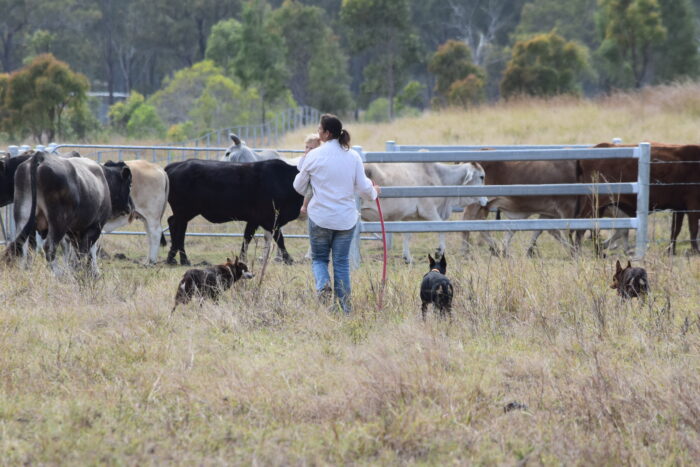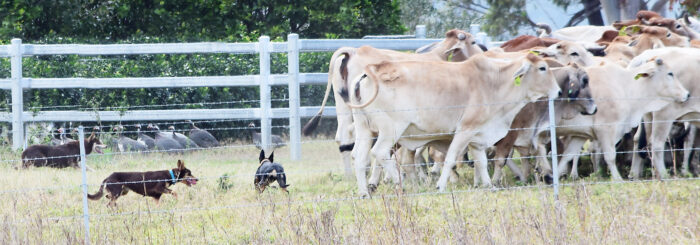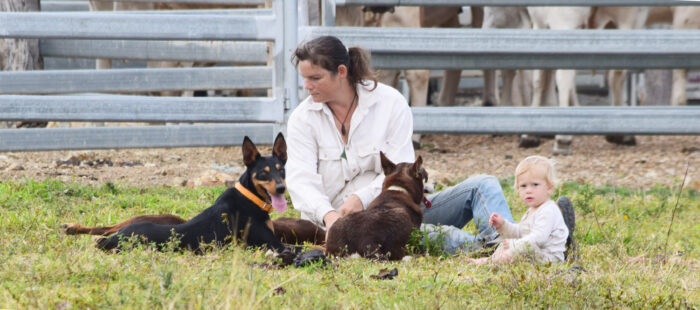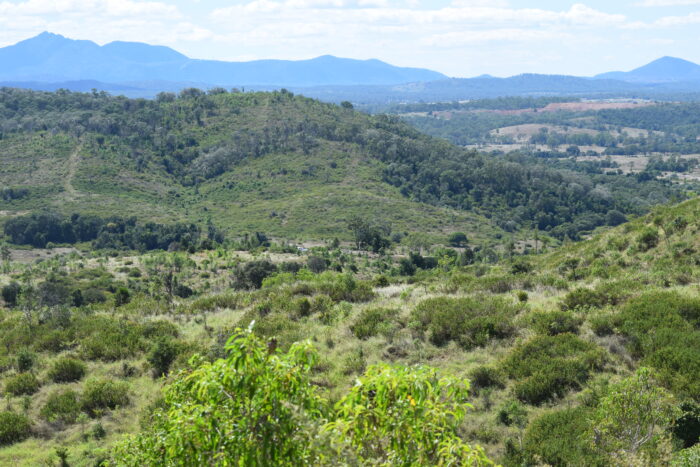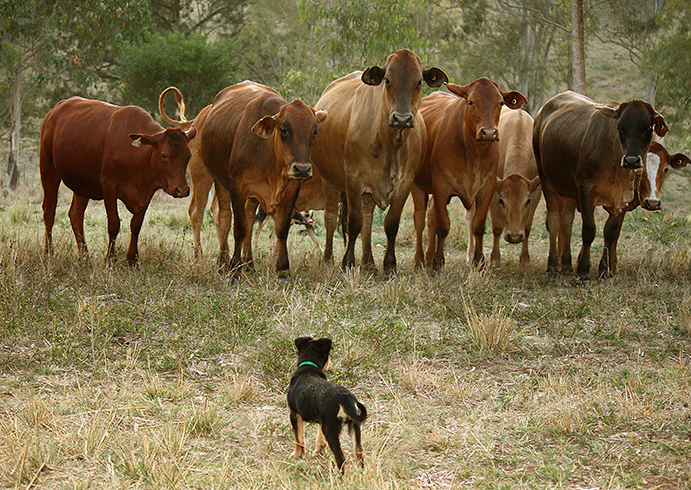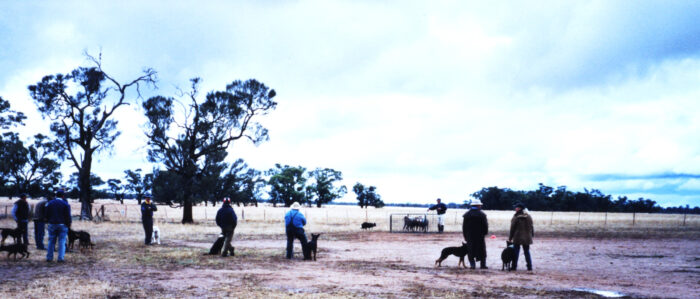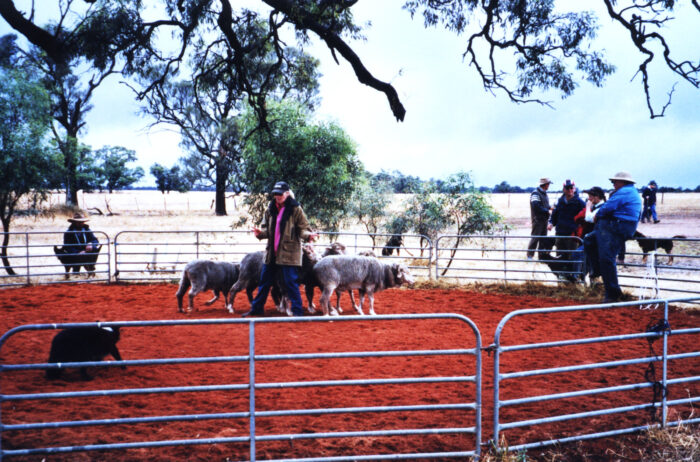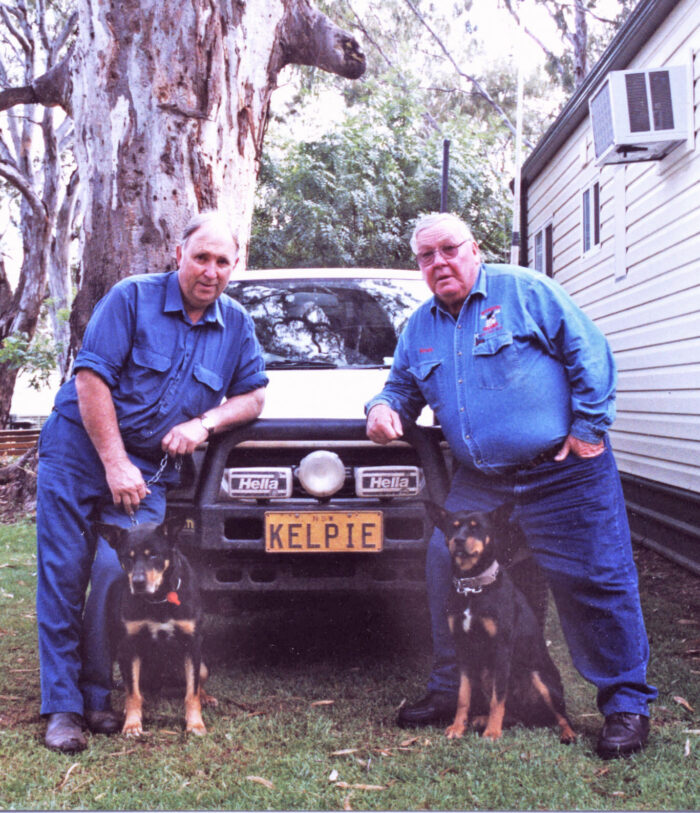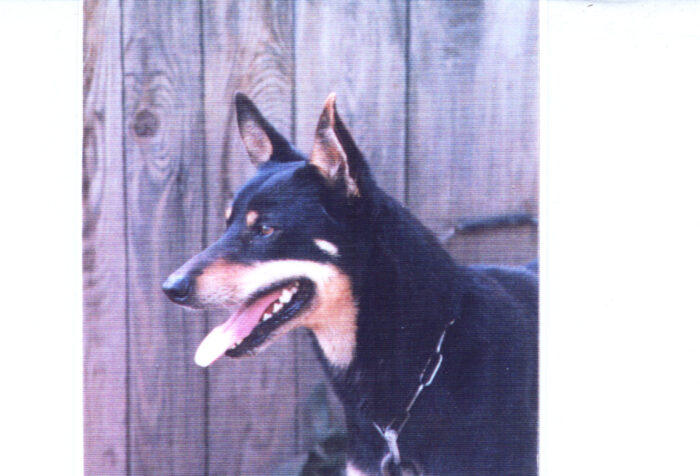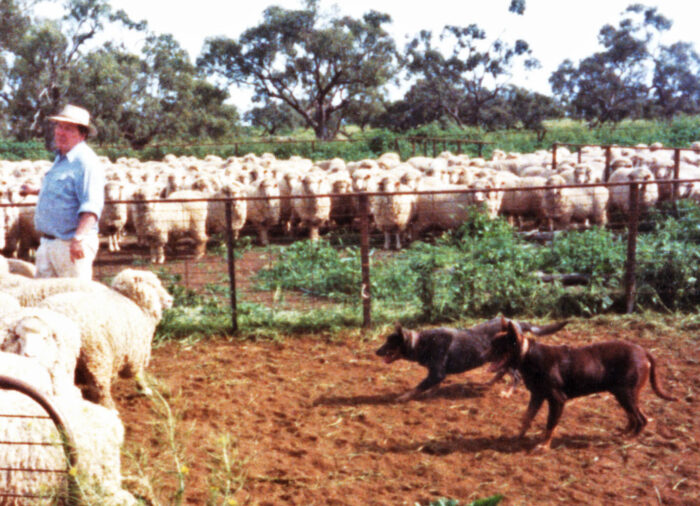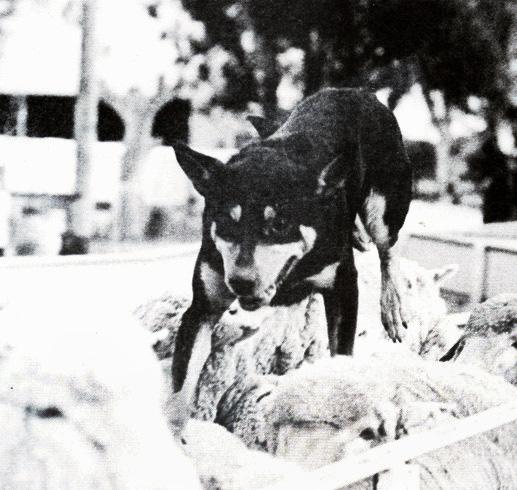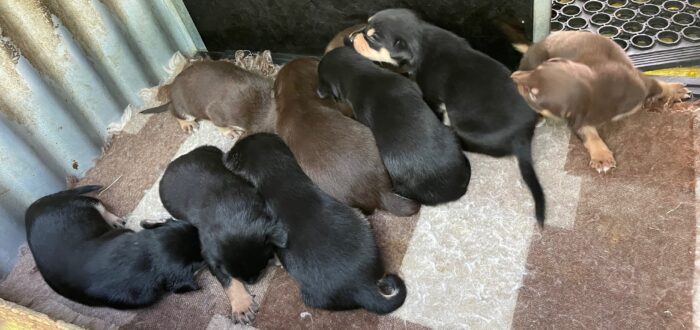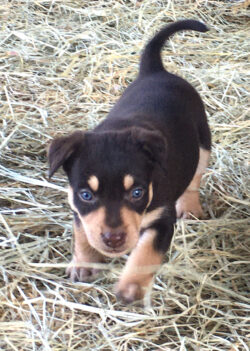March 2023
I can’t believe two months have already disappeared from the calendar! It’s nice to be heading into Autumn, my favourite season, but also a bit worrying as to what it will pop up in the way of unseasonal weather. This seems to be the norm lately.
I heard last week that 30% of Queensland is in drought and find it easy to believe looking around my local district…. but areas quite close have some good crops, a very unfair fact.
Dog numbers are down here at present. I have three (hopefully) pregnant bitches, Sass to Blye, Midnight to Comet and Mina to Joaker. (Well Mina missed but Sass now has eight dog pups by Joaker! She was backed up because of mating Blye so early.)
Two bitches with pups, Heli and Livvy.
Brock, Wiggle, Cap, Vamp and Bright….hooning around enjoying life!
Wiggle and Naka should be the next to cycle. Livvy is absolutely breezing along at present feeding her nine, she’s such an easy bitch and will eat anything which is a huge bonus with brood bitches.
I’ve been revising my website info, it doesn’t take long for things to change a bit. Sass and Mina are getting their own pages and Gibson and Sunny will soon have theirs too. I’m hoping Derek can get me some good photos of them working that I’ll be able to use. They were down mid Feb and brought some lovely photos Derek took of Em and the dogs walking cows to the yards.
Dogs are Mina(orange), Fizz(white), Sass (light blue) Naka(darker blue).
It’s challenging country and ideal for sorting out the dogs!
I have an older order for a pup in my book and yesterday received an enquiry as to how long before she’d be ready. As usual, I asked more questions because I like to knows much as possible about the situation the pup is going into, it helps me choose the most suitable pup.
In this case I’m really pleased I did; the property runs breeders and doesn’t have any other dogs at present. I don’t think it’s fair to expect a pup to start working cattle without backup and suggested he call about an older pup I saw advertised. I also have another order from a previous client who was in the same situation; he wants a stronger pup this time. The first one is working well but lacks confidence…… hardly surprising. I’m pretty sure a pup in this situation wouldn’t be put away to grow up or be started on sheep. It’s like expecting a kid at preschool to play in the Under 12 footy team. But I’m sure you’re well aware of all that. Reminded me of this photo I took of Tracker Clancy long ago at Oakwood! Incidentally, Clancy is the g’dam of Eventine Comet.
I found a lot of old photos Rick Sims sent me years ago(when I went looking for the one above!) there are some of old dogs in my pedigrees, a lot of Wyreema dogs, and a couple of Gordy McMaster. This was the first one I found and I immediately recognised Gordy! I had quite a bit to do with him when showing sheep, and tried to get a nice bitch from him by swapping for sheepskin coats, which I was making back then. I ended up sending them all back(he shot the 3), and when he opened an employment agency I reminded him that it didn’t work, sending the hopeless ones far away, they always came home to roost. He roared laughing.
Rick went to Germany with Gordy on an educational dog clinic visit.
From bottom going up: Avenpart Zondo,Nacomma Hammer, Wyreema Gerry and Wally Lewis with Gordy sheep classing, Kamad Sailor, Rick with Wyreema Willis and Gordy with Backenbark Sonny.
Thanks to Rick for naming all the photos, something I should do more often.
Well, this month’s news has turned into a bit of history! Here are Livvy’s pups to finish up… the weather has been very changeable, it’s amazing how they organise themselves. They roll out to the front of the kennel in the afternoon when the sun comes onto the back door and back onto their warm bed at night. I’ve only had to put the sprinkler on when it gets up to 35’C! Two weeks old here.
March 26…..and a few weeks later!
I’ve had reason to go digging into how genetic inheritance can be influenced by bad feeding practices lately(read feeding dry food, as most people believe the info on the bags). We’ve introduced a few outside bitches and all have presented with health issues over time. I’ve fed my dogs raw for many years, and the dogs with Em and Derek are also on raw. We have never had any of the issues that they have presented with. I’ll copy the result of my hunt below, it’s also on the Pups for Sale page. It’s a long read but fascinating….this is how it all started:
So over 20 years on I’m circling back to old Karrawarra Rip III, it seems…. Thunder’s g’sire on both sides and Joaker is also by Thunder. It’s funny that Sheps Sandy also has common g’sires in Campbell’s Reg and Elwanvale Sunny in Wickham’s Tex. Carrying that back to the Sandy pup we bought, her sire has common g’dams in Karra.Lisa II who was by Coster( x Akubra). Tony Parsons took me to see Coster one day and he wouldn’t come out of his kennel. This is the sort of thing I had no idea about when I started breeding kelpies, but as you get older and maybe a little wiser, you learn a lot about the dogs in your pedigrees. As I look back with the benefit of hindsight all I can do is wonder why some matings were done, some of mine included.
Maybe this close breeding will cut out the in-between step when outcrossing; generally speaking the best results are from the next generation of 25% introduced blood but this sort of thing can have unexpected results. For example, a “double up” mating would be done to get twice as much of the good points in the dog/bitch used, but of course you’re also doubling up on undesirable traits that might not be obvious but will possibly surface…..
Interesting! Well, maybe only to those interested in bloodlines and they seem to getting pretty thin on the ground these days.
The kelpie has a relatively small genetic base and this mating of ‘1/2 siblings’ is not good for the breed long term because it reduces the variation even more. At least the WKC has an open stud book and unregistered dogs can be introduced through the Appendix system. This was a great idea, and has saved the contribution that a lot of good dogs have made which would not have been possible otherwise. The main problem these days is the proliferation of studs and preference for WKC registered dogs which has reduced the size of the genetic base considerably.
There are many disadvantages in breeding close, as can be seen by taking a look at the “pure” breeds registered with the KCC and the reduction of breed numbers. They are reaping the result of closed stud books and over- use of “superior” sires both within the breeds and also within studs….the restrictions coming in to regulate the number of litters a bitch can have are also extremely detrimental to the ongoing quality of pups being produced(especially as I believe the bitch has more influence on a litter through the mitochondria.) I prefer not to do closer matings myself.
I’ve been told that poor feeding over generations can affect the health of pups born, and went hunting through available information to find out why. Dogs(and people) depend on healthy mitochondria, “they are the power houses of the cell providing the body with over 90% of the energy it needs to sustain life.” Every cell has masses of mitochondria.
Mitochondria take in sugars and proteins from the food we eat and produce energy called ATP that our bodies use to function properly. Mitochondrial disease is a debilitating and potentially fatal disease that reduces the ability of the mitochondria to produce this energy. When the mitochondria are not working properly, cells begin to die until eventually whole organ systems fail and life itself is compromised. They require the right amount of protein, fats, carbohydrates, vitamins and minerals to function properly. Imbalances can cause the build up of potentially dangerous by products which eventually compromise DNA function. When a cell is filled with defective mitochondria, not only does it become deprived of ATP, it also can accumulate a backlog of unused fuel molecules and oxygen, with potentially disastrous effects. ATP derived from mitochondria provides the main source of power for muscle cell contraction and nerve cell firing. So, muscle cells and nerve cells are especially sensitive to mitochondrial defects/mutations.
Mutations in either nuclear(cell) DNA (nDNA) or mitochondrial DNA (mtDNA) can cause mitochondrial disease.
Most nDNA (along with any mutations it has) is inherited in a Mendelian pattern, loosely meaning that one copy of each gene comes from each parent and it takes mutations in both copies of a gene to cause disease.
Unlike nDNA, mtDNA passes only from mother to child. That is because during conception, when the sperm fuses with the egg, the sperm’s mitochondria — and its mtDNA — are destroyed. Thus, mitochondrial diseases caused by mtDNA mutations are unique because they are inherited only from the mother.
Another unique feature of mtDNA diseases arises from the fact that a typical human cell — including the egg cell — contains only one nucleus but hundreds of mitochondria. A single cell can contain both mutant mitochondria and normal mitochondria, and the balance between the two will determine the cell’s health. This helps explain why the symptoms of mitochondrial disease can vary so much from person to person, even within the same family.
What are the symptoms of mitochondrial myopathies?
Muscular and neurological problems — such as muscle weakness, exercise intolerance, hearing loss, trouble with balance and coordination, seizures, and learning deficits — are common features of mitochondrial disease because muscle cells and nerve cells have especially high energy needs. Other frequent complications include impaired vision, heart defects, diabetes, stunted growth, allergies and systemic inflammation.
Do any of these ring a bell with symptoms related to very close inbreeding of dogs? Or to many common ailments dogs are presenting with? Or, indeed, with many of the huge avalanche of human illnesses presenting in recent decades led by obesity? The proliferation of fast food, sugary drinks, refined flour products, other carbs, etc. might just have something to do with it.
So it’s really obvious how vital a good diet is for healthy mitochondria, right? Not surprisingly, foods to be avoided include ones known to fuel cancer….. the perpetual pandemic, and the other ones, dementia/Alzheimers and diabetes have been linked also. I could possibly add autism, as nobody seems to know what causes it.
It’s only a short jump to the poor quality dry foods being marketed to feed dogs. I’ve written elsewhere about the benefits of a raw diet. Once again I mention Dr Conor Brady’s book “Feeding Dogs”.
And if you’re wondering what led me down this particular rabbit hole? If you feed a bitch a poor diet over many years it’s possible to compromise her mitochondria. If you then double up on the weakness and mate two of her pups by different sires? To my simple mind you’re doubling the possibility that those pups could also have ‘weakened’ mitochondria which could lead to muscle and nerve problems. The shortened life spans and multiple illnesses dogs are suffering more frequently…….?
And often the vets are recommending special dry foods to treat them, when more than likely the food is at least part of the problem.
